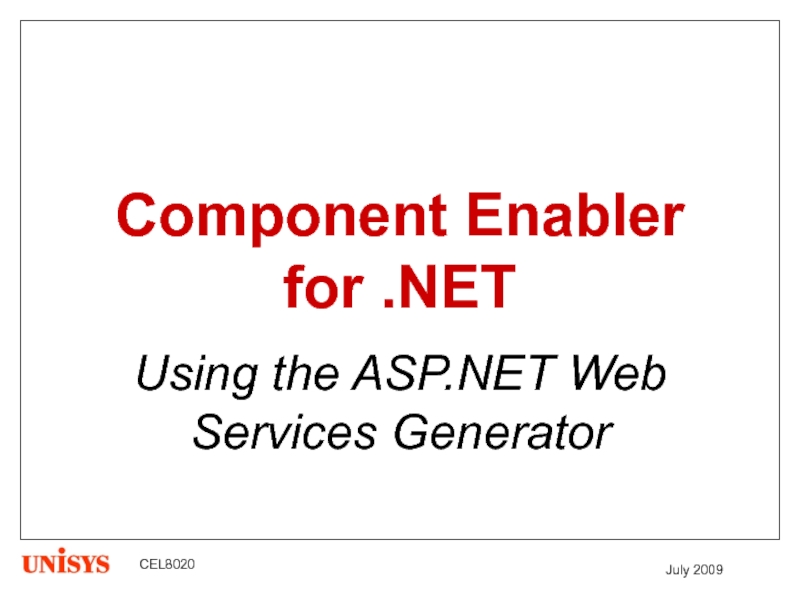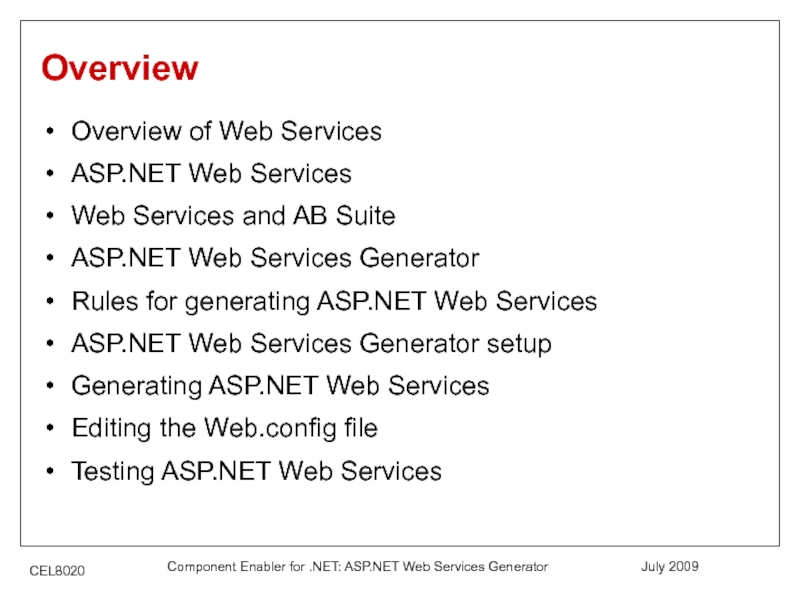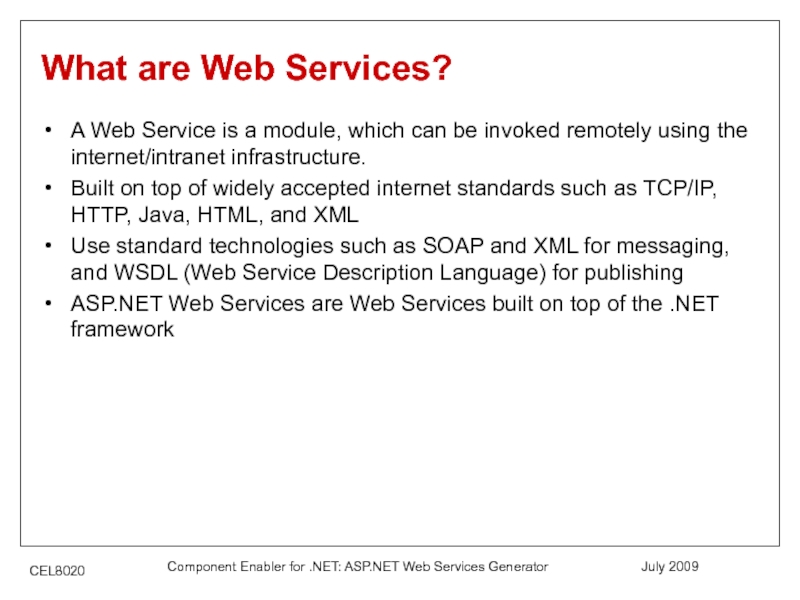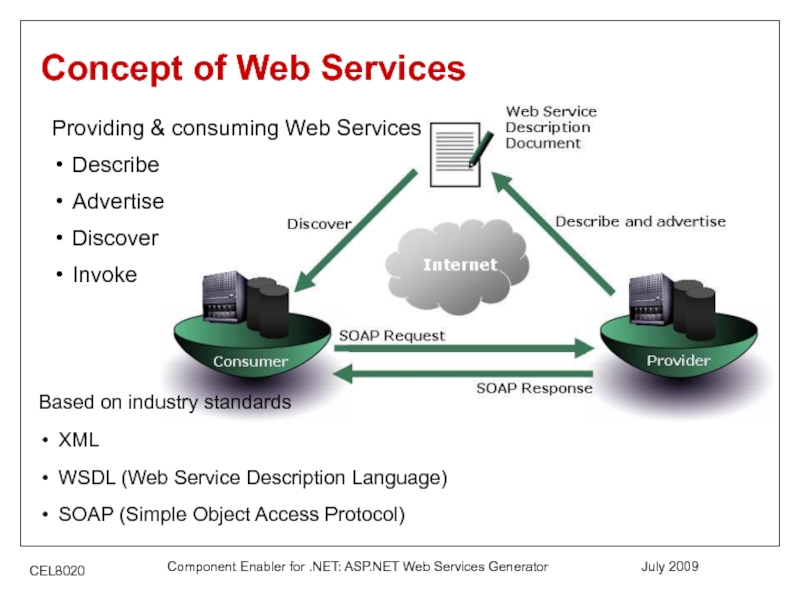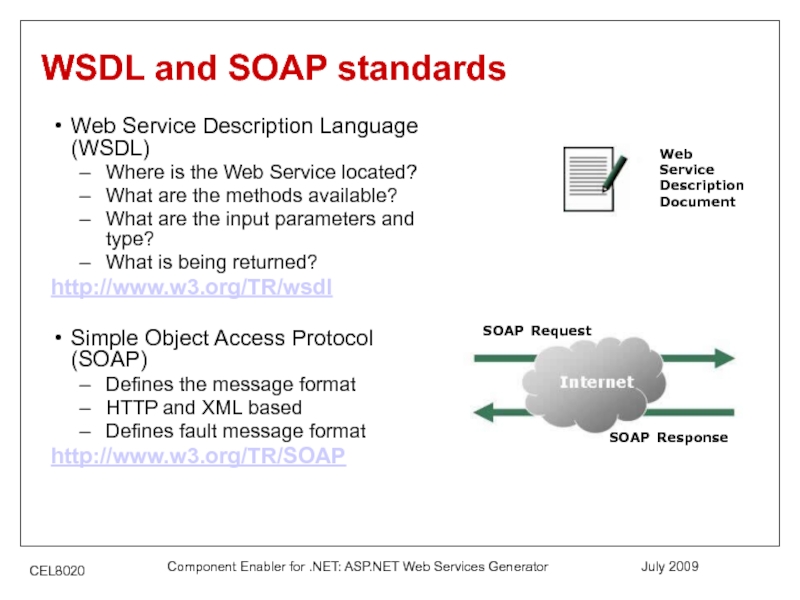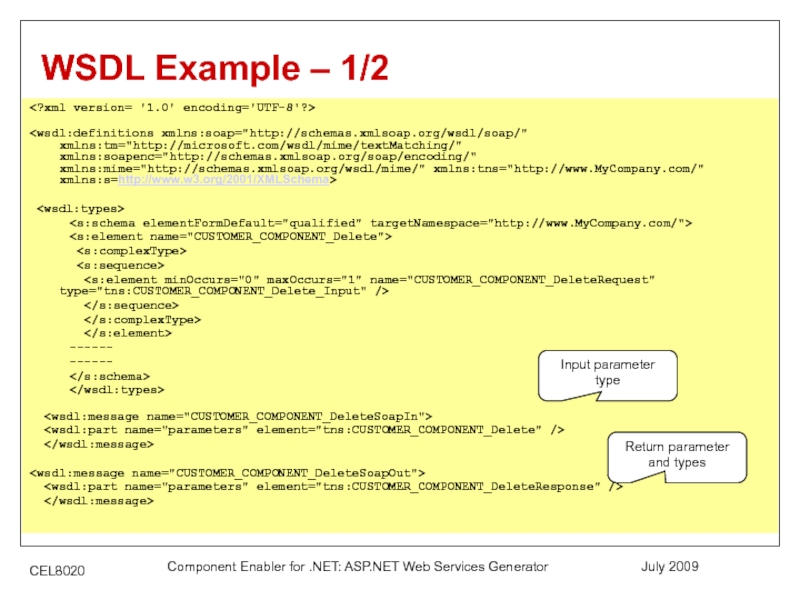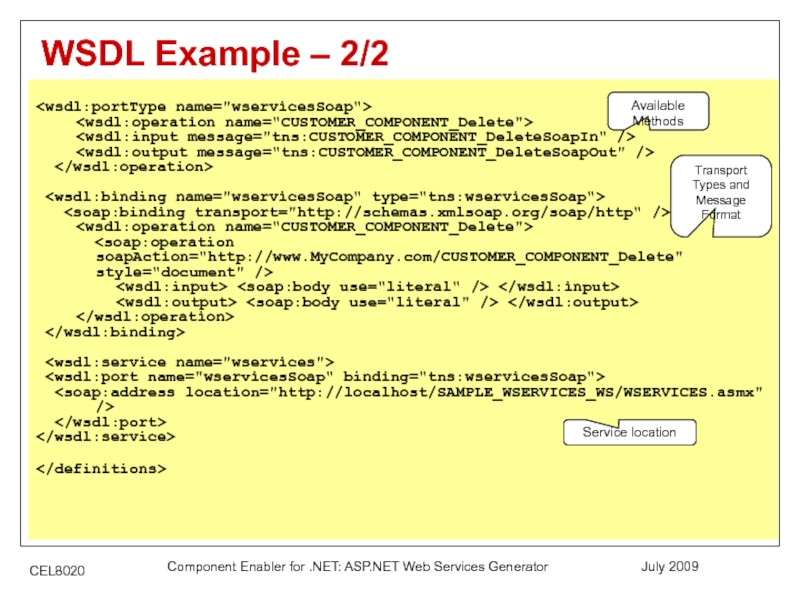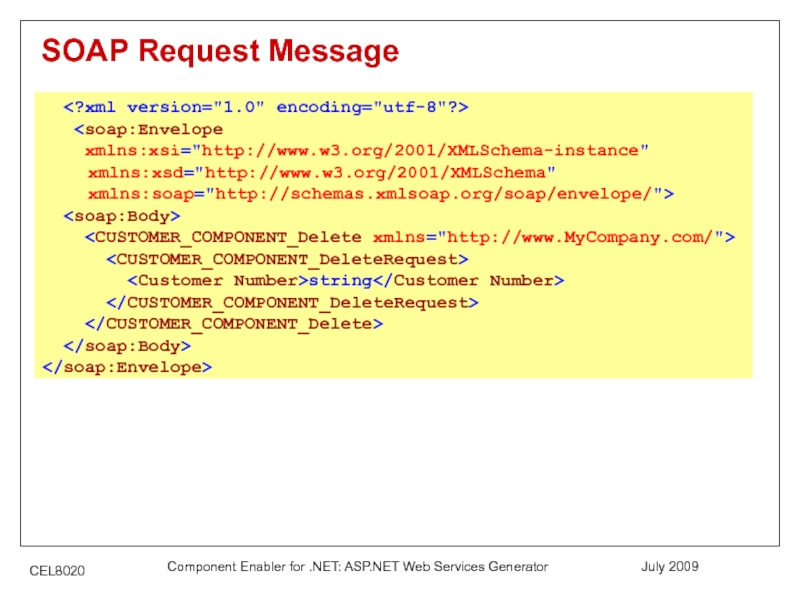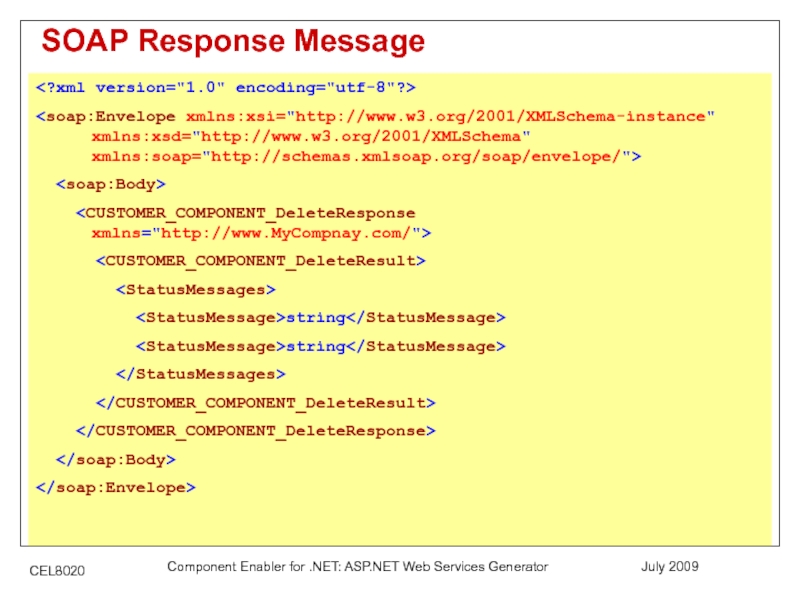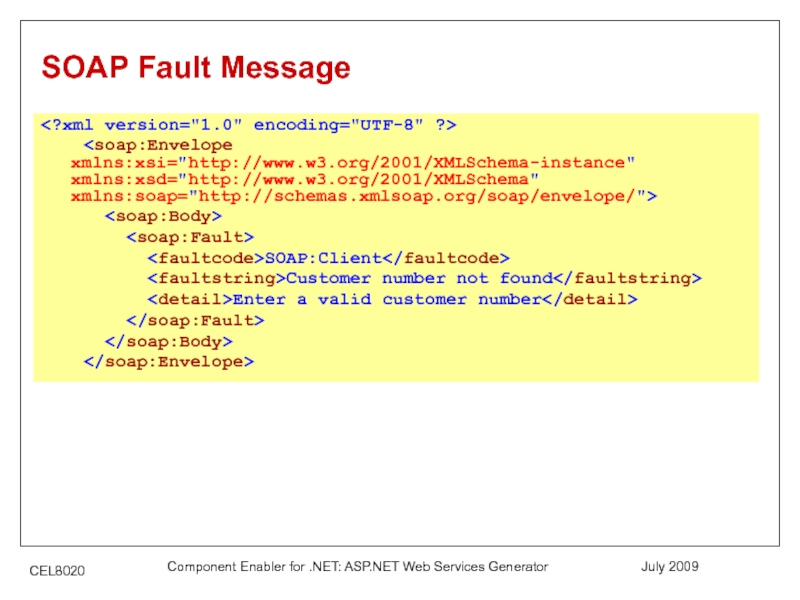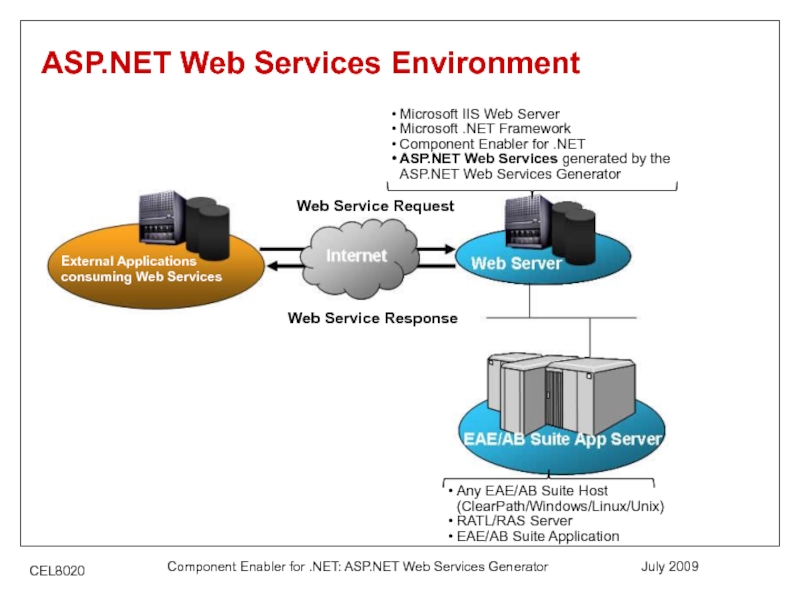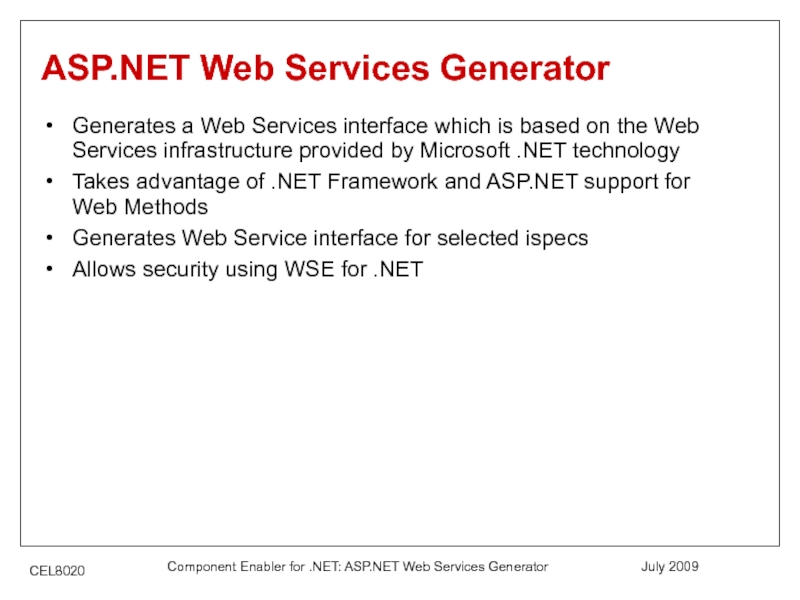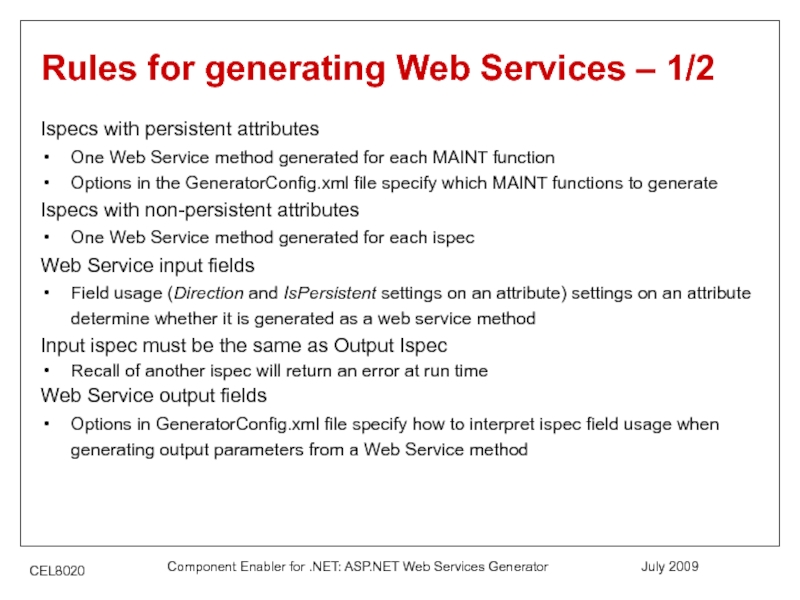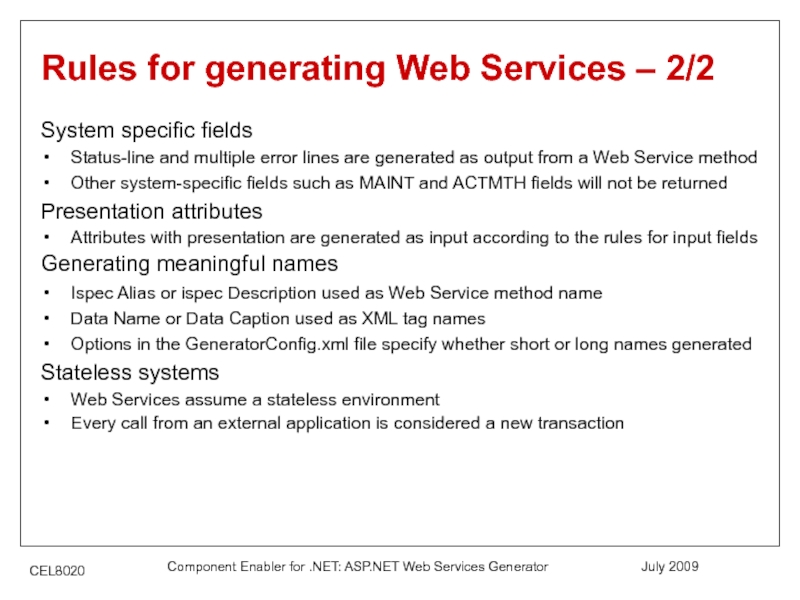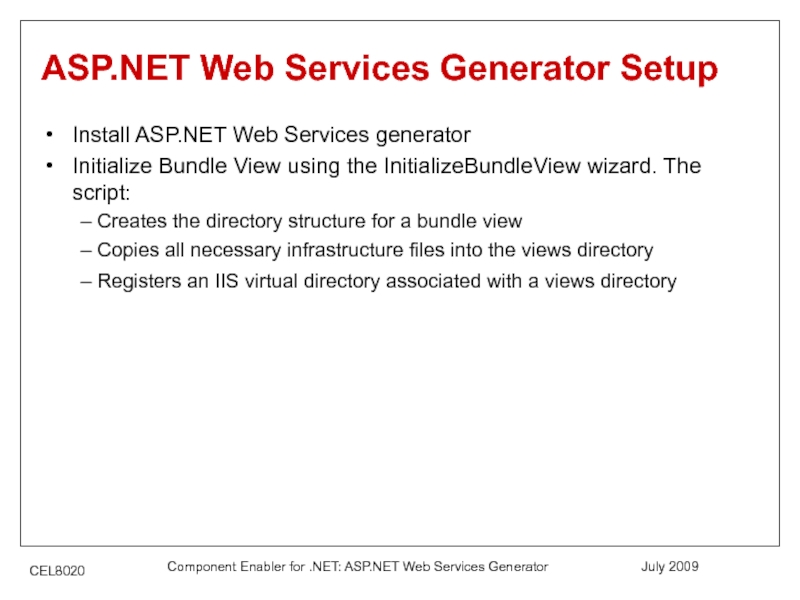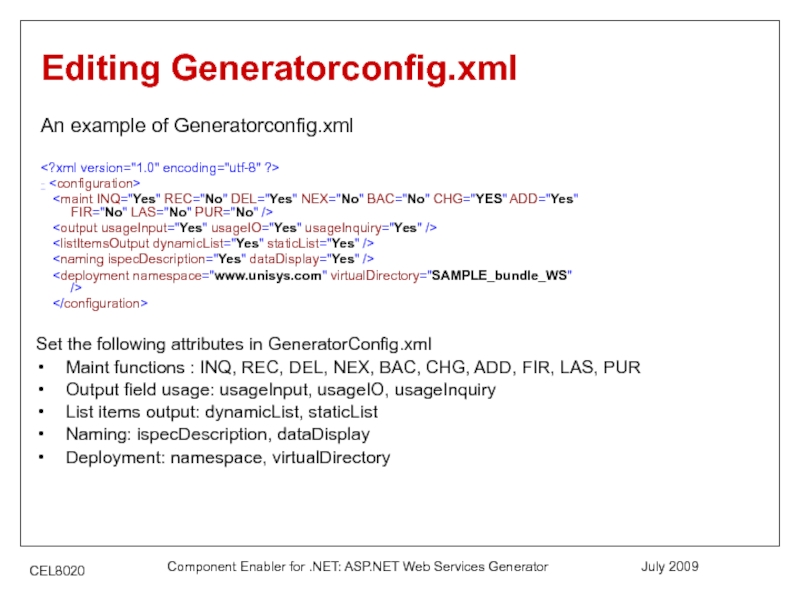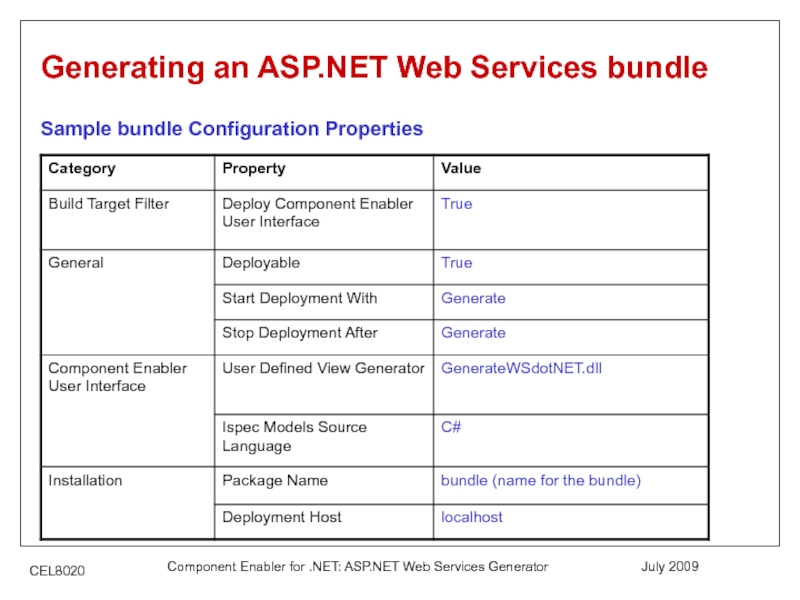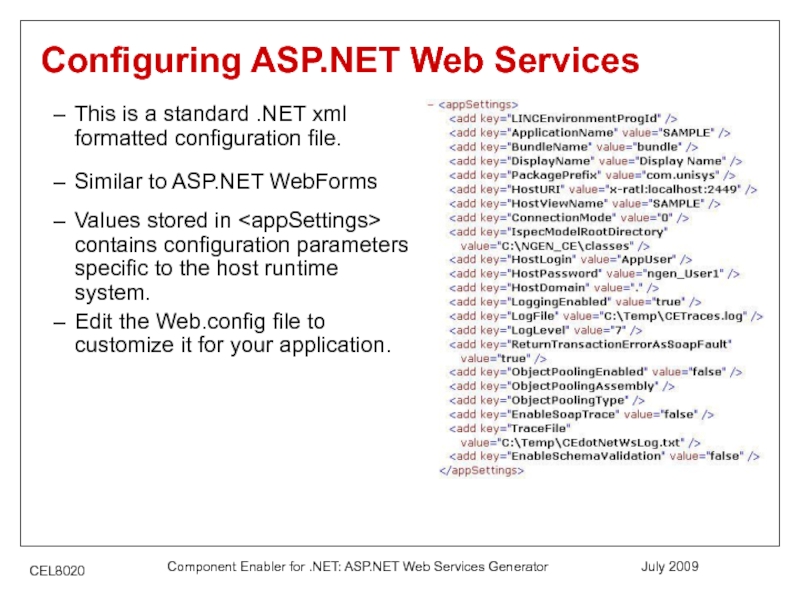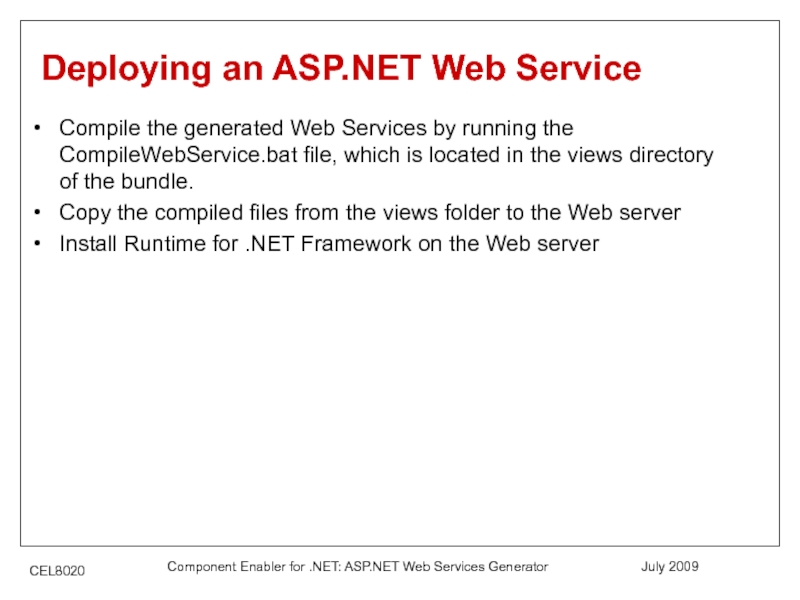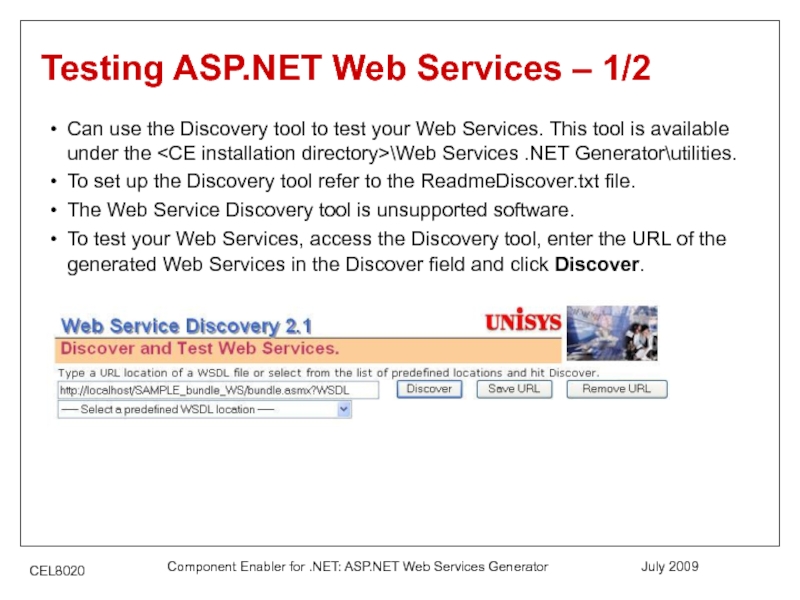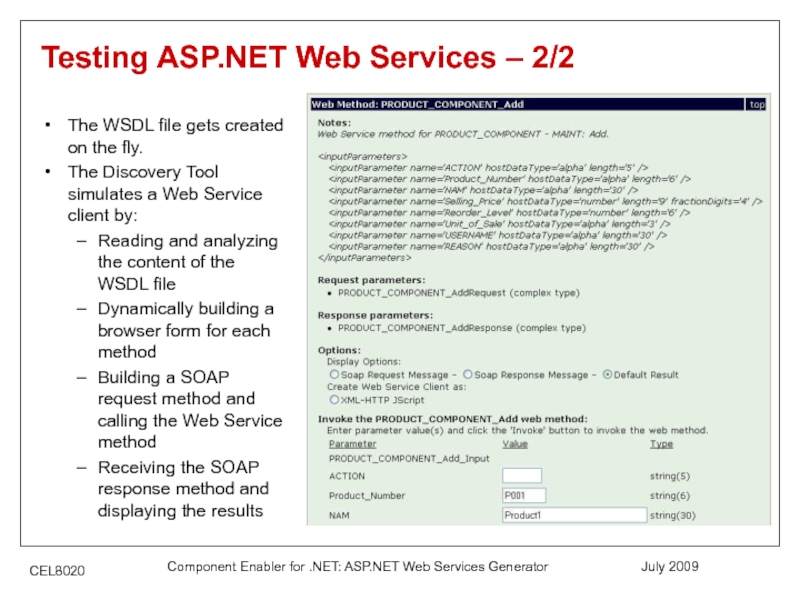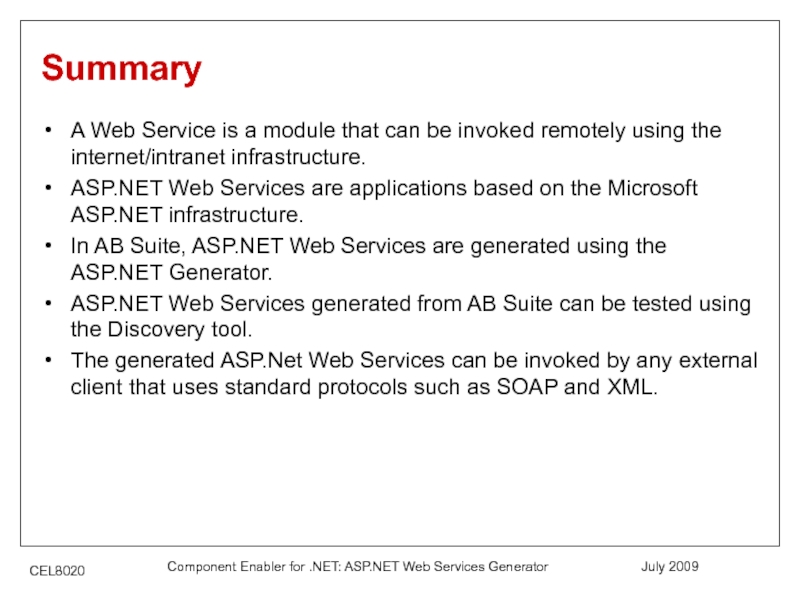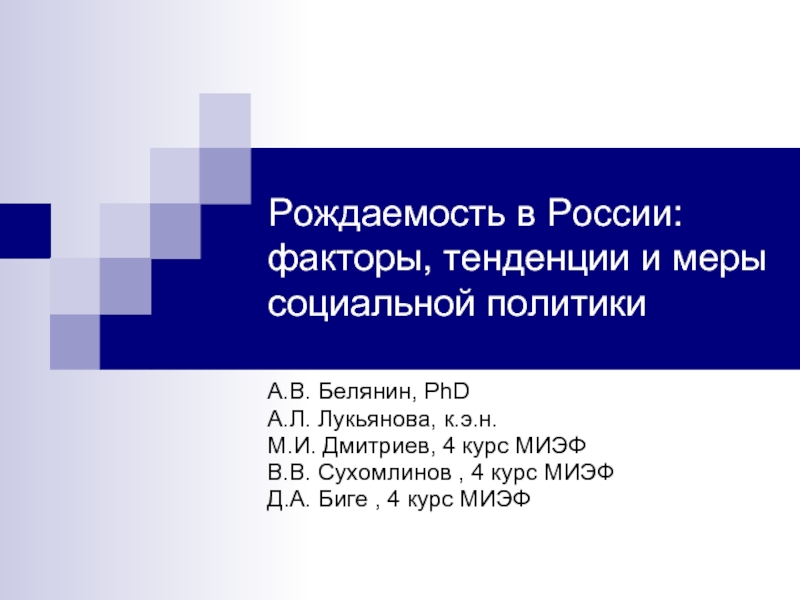- Главная
- Разное
- Дизайн
- Бизнес и предпринимательство
- Аналитика
- Образование
- Развлечения
- Красота и здоровье
- Финансы
- Государство
- Путешествия
- Спорт
- Недвижимость
- Армия
- Графика
- Культурология
- Еда и кулинария
- Лингвистика
- Английский язык
- Астрономия
- Алгебра
- Биология
- География
- Детские презентации
- Информатика
- История
- Литература
- Маркетинг
- Математика
- Медицина
- Менеджмент
- Музыка
- МХК
- Немецкий язык
- ОБЖ
- Обществознание
- Окружающий мир
- Педагогика
- Русский язык
- Технология
- Физика
- Философия
- Химия
- Шаблоны, картинки для презентаций
- Экология
- Экономика
- Юриспруденция
Component Enabler for .NET презентация
Содержание
- 1. Component Enabler for .NET
- 2. July 2009 Component Enabler for .NET: ASP.NET
- 3. July 2009 Component Enabler for .NET: ASP.NET
- 4. July 2009 Component Enabler for .NET: ASP.NET
- 5. July 2009 Component Enabler for .NET: ASP.NET
- 6. July 2009 Component Enabler for .NET: ASP.NET
- 7. July 2009 Component Enabler for .NET: ASP.NET
- 8. July 2009 Component Enabler for .NET: ASP.NET
- 9. July 2009 Component Enabler for .NET: ASP.NET
- 10. July 2009 Component Enabler for .NET: ASP.NET
- 11. July 2009 Component Enabler for .NET: ASP.NET
- 12. July 2009 Component Enabler for .NET: ASP.NET
- 13. July 2009 Component Enabler for .NET: ASP.NET
- 14. July 2009 Component Enabler for .NET: ASP.NET
- 15. July 2009 Component Enabler for .NET: ASP.NET
- 16. July 2009 Component Enabler for .NET: ASP.NET
- 17. July 2009 Component Enabler for .NET: ASP.NET
- 18. July 2009 Component Enabler for .NET: ASP.NET
- 19. July 2009 Component Enabler for .NET: ASP.NET
- 20. July 2009 Component Enabler for .NET: ASP.NET
- 21. July 2009 Component Enabler for .NET: ASP.NET
- 22. July 2009 Component Enabler for .NET: ASP.NET
Слайд 2July 2009
Component Enabler for .NET: ASP.NET Web Services Generator
Overview
Overview of Web
ASP.NET Web Services
Web Services and AB Suite
ASP.NET Web Services Generator
Rules for generating ASP.NET Web Services
ASP.NET Web Services Generator setup
Generating ASP.NET Web Services
Editing the Web.config file
Testing ASP.NET Web Services
Слайд 3July 2009
Component Enabler for .NET: ASP.NET Web Services Generator
What are Web
A Web Service is a module, which can be invoked remotely using the internet/intranet infrastructure.
Built on top of widely accepted internet standards such as TCP/IP, HTTP, Java, HTML, and XML
Use standard technologies such as SOAP and XML for messaging, and WSDL (Web Service Description Language) for publishing
ASP.NET Web Services are Web Services built on top of the .NET framework
Слайд 4July 2009
Component Enabler for .NET: ASP.NET Web Services Generator
Concept of Web
Providing & consuming Web Services
Describe
Advertise
Discover
Invoke
Based on industry standards
XML
WSDL (Web Service Description Language)
SOAP (Simple Object Access Protocol)
Слайд 5July 2009
Component Enabler for .NET: ASP.NET Web Services Generator
WSDL and SOAP
Web Service Description Language (WSDL)
Where is the Web Service located?
What are the methods available?
What are the input parameters and type?
What is being returned?
http://www.w3.org/TR/wsdl
Simple Object Access Protocol (SOAP)
Defines the message format
HTTP and XML based
Defines fault message format
http://www.w3.org/TR/SOAP
Web Service
Description
Document
SOAP Request
SOAP Response
Слайд 6July 2009
Component Enabler for .NET: ASP.NET Web Services Generator
WSDL Example –
Input parameter type Return parameter and types
------
------
Слайд 7July 2009
Component Enabler for .NET: ASP.NET Web Services Generator
WSDL Example –
Available Methods Transport Types and Message Format Service location
Слайд 8July 2009
Component Enabler for .NET: ASP.NET Web Services Generator
SOAP Request Message
Слайд 9July 2009
Component Enabler for .NET: ASP.NET Web Services Generator
SOAP Response Message
Слайд 10July 2009
Component Enabler for .NET: ASP.NET Web Services Generator
SOAP Fault Message
Слайд 11July 2009
Component Enabler for .NET: ASP.NET Web Services Generator
ASP.NET Web Services
Web Service Request
Web Service Response
External Applications
consuming Web Services
Слайд 12July 2009
Component Enabler for .NET: ASP.NET Web Services Generator
ASP.NET Web Services
Generates a Web Services interface which is based on the Web Services infrastructure provided by Microsoft .NET technology
Takes advantage of .NET Framework and ASP.NET support for Web Methods
Generates Web Service interface for selected ispecs
Allows security using WSE for .NET
Слайд 13July 2009
Component Enabler for .NET: ASP.NET Web Services Generator
Rules for generating
Ispecs with persistent attributes
One Web Service method generated for each MAINT function
Options in the GeneratorConfig.xml file specify which MAINT functions to generate
Ispecs with non-persistent attributes
One Web Service method generated for each ispec
Web Service input fields
Field usage (Direction and IsPersistent settings on an attribute) settings on an attribute determine whether it is generated as a web service method
Input ispec must be the same as Output Ispec
Recall of another ispec will return an error at run time
Web Service output fields
Options in GeneratorConfig.xml file specify how to interpret ispec field usage when generating output parameters from a Web Service method
Слайд 14July 2009
Component Enabler for .NET: ASP.NET Web Services Generator
Rules for generating
System specific fields
Status-line and multiple error lines are generated as output from a Web Service method
Other system-specific fields such as MAINT and ACTMTH fields will not be returned
Presentation attributes
Attributes with presentation are generated as input according to the rules for input fields
Generating meaningful names
Ispec Alias or ispec Description used as Web Service method name
Data Name or Data Caption used as XML tag names
Options in the GeneratorConfig.xml file specify whether short or long names generated
Stateless systems
Web Services assume a stateless environment
Every call from an external application is considered a new transaction
Слайд 15July 2009
Component Enabler for .NET: ASP.NET Web Services Generator
ASP.NET Web Services
Install ASP.NET Web Services generator
Initialize Bundle View using the InitializeBundleView wizard. The script:
Creates the directory structure for a bundle view
Copies all necessary infrastructure files into the views directory
Registers an IIS virtual directory associated with a views directory
Слайд 16July 2009
Component Enabler for .NET: ASP.NET Web Services Generator
Editing Generatorconfig.xml
An example
-
Set the following attributes in GeneratorConfig.xml
Maint functions : INQ, REC, DEL, NEX, BAC, CHG, ADD, FIR, LAS, PUR
Output field usage: usageInput, usageIO, usageInquiry
List items output: dynamicList, staticList
Naming: ispecDescription, dataDisplay
Deployment: namespace, virtualDirectory
Слайд 17July 2009
Component Enabler for .NET: ASP.NET Web Services Generator
Generating an ASP.NET
Sample bundle Configuration Properties
Слайд 18July 2009
Component Enabler for .NET: ASP.NET Web Services Generator
Configuring ASP.NET Web
This is a standard .NET xml formatted configuration file.
Similar to ASP.NET WebForms
Values stored in
Edit the Web.config file to customize it for your application.
Слайд 19July 2009
Component Enabler for .NET: ASP.NET Web Services Generator
Deploying an ASP.NET
Compile the generated Web Services by running the CompileWebService.bat file, which is located in the views directory of the bundle.
Copy the compiled files from the views folder to the Web server
Install Runtime for .NET Framework on the Web server
Слайд 20July 2009
Component Enabler for .NET: ASP.NET Web Services Generator
Testing ASP.NET Web
Can use the Discovery tool to test your Web Services. This tool is available under the
To set up the Discovery tool refer to the ReadmeDiscover.txt file.
The Web Service Discovery tool is unsupported software.
To test your Web Services, access the Discovery tool, enter the URL of the generated Web Services in the Discover field and click Discover.
Слайд 21July 2009
Component Enabler for .NET: ASP.NET Web Services Generator
Testing ASP.NET Web
The WSDL file gets created on the fly.
The Discovery Tool simulates a Web Service client by:
Reading and analyzing the content of the WSDL file
Dynamically building a browser form for each method
Building a SOAP request method and calling the Web Service method
Receiving the SOAP response method and displaying the results
Слайд 22July 2009
Component Enabler for .NET: ASP.NET Web Services Generator
Summary
A Web Service
ASP.NET Web Services are applications based on the Microsoft ASP.NET infrastructure.
In AB Suite, ASP.NET Web Services are generated using the ASP.NET Generator.
ASP.NET Web Services generated from AB Suite can be tested using the Discovery tool.
The generated ASP.Net Web Services can be invoked by any external client that uses standard protocols such as SOAP and XML.
